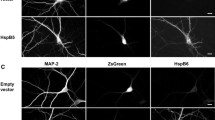Abstract
Preadaptation of cultured HT22 mouse hippocampal neurons to oxidative stress prevented cell damage induced by severe oxidative stress. This protection manifested in a decrease in metabolic disturbances in neurons. Adaptation of neurons to oxidative stress was accompanied by accumulation of HSP32 and HSP70. HSP synthesis inhibitor quercetin abolished the protective effect of adaptation under conditions of oxidative stress. Activation of HSP70 synthesis in neurons is an important mechanism for adaptive protection of cells.
Similar content being viewed by others
References
Yu. V. Arkhipenko, T. G. Sazontova, and A. G. Zhukova, Byull. Eksp. Biol. Med., 140, No. 9, 257–260 (2005).
E. B. Manukhina, F. Viegant, V. I. Torshin, et al., Izv. Akad. Nauk. Ser. Biol., No. 4, 465–480 (2004).
F. Z. Meerson, Adaptive Medicine: Mechanisms and Protective Effects of Adaptation [in Russian], Moscow (1993).
M. G. Pshennikova, E. V. Popkova, I. P. Khomenko, et al., Byull. Eksp. Biol. Med., 139, No. 5, 491–494 (2005).
Z. H. Chen, Y. Yoshida, Y. Saito, and E. Niki, Neurosci. Lett., 383, No. 3, 256–259 (2005).
L. A. Gomez, A. E. Alekseev, L. A. Aleksandrova, et al., J. Mol. Cell. Cardiol., 29, No. 4, 1255–1266 (1997).
U. K. Laemmli, Nature, 227, 680–685 (1970).
I. Yu. Malyshev, L. A. Bayda, A. I. Trifonov, et al., Physiol. Res., 49, No. 11, 99–105 (2000).
B. H. Morimoto and D. E. Koshland, Neuron, 5, No. 6, 875–880 (1990).
G. Perry, A. D. Cash, and M. A. Smith, J. Biomed. Biotechnol., 2, No. 3, 120–123 (2002).
O. G. Rossler, I. Bauer, H. Y. Chung, and G. Thiel, Neurosci. Lett., 362, No. 3, 253–257 (2004).
Y. Sagara, S. Hendler, S. Khoh-Reiter, et al., J. Neurochem., 73, No. 6, 2524–2530 (1999).
B. Y. Wu and A. C. Yu, J. Neurosci. Res., 62, No. 5, 730–736 (2000).
M. A. Yenari, J. Liu, Z. Zheng, et al., Ann. N. Y. Acad. Sci., 1053, 74–83 (2005).
Author information
Authors and Affiliations
Corresponding author
Additional information
__________
Translated from Byulleten’ Eksperimental’noi Biologii i Meditsiny, Vol. 144, No. 8, pp. 138–142, August, 2007
Rights and permissions
About this article
Cite this article
Khomenko, I.P., Bakhtina, L.Y., Zelenina, O.M. et al. Role of heat shock proteins HSP70 and HSP32 in the protective effect of adaptation of cultured HT22 hippocampal cells to oxidative stress. Bull Exp Biol Med 144, 174–177 (2007). https://doi.org/10.1007/s10517-007-0282-9
Received:
Issue Date:
DOI: https://doi.org/10.1007/s10517-007-0282-9




